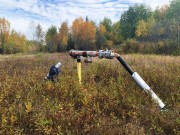Researchers across the country are submitting full project proposals this week as part of Natural Resources Canada’s developing Methane Centre of Excellence. Environment Minister Stephen Guilbeault announced $30 million for the Centre last year at COP28, alongside the federal government’s draft amendments to its oil and gas methane regulations. Those regulations are designed to achieve a 75% reduction of oil and gas methane emissions by 2030 (from 2012 levels).
The Pembina Institute and other environmental organizations have long advocated for a Methane Centre of Excellence to address data quality issues and move Canada toward improved measurement, monitoring, reporting and verification (MMRV). With a stated focus on energy sector methane and MMRV, the Methane Centre of Excellence has the potential to improve our collective understanding of oil and gas methane emissions in Canada – if it is well-designed and adequately funded.
What is methane?
Methane is a potent climate warmer, with over 80 times the warming power of carbon dioxide in a 20-year timespan and potentially severe associated air quality and health impacts. Canada’s oil and gas sector is responsible for nearly 50% of Canada’s human-caused methane emissions. However, proven, cost-effective solutions exist to abate those emissions – from finding and fixing leaks; to swapping out leak-prone equipment; to capturing and using or selling gas that would otherwise go to waste.
What is a “centre of excellence”?
A centre of excellence is a hub in which subject-matter experts convene, coordinate, and collaborate to advance the state of research, collect and analyze data, develop solutions to urgent problems, foster the development and adoption of innovation, improve or standardize methodologies, share knowledge and provide training, and/or derive policy recommendations. For instance, the Natural Sciences and Engineering Research Council’s FlareNet Strategic Network brings together a wide range of stakeholders to quantify and minimize the impacts of energy sector gas flaring.
These centres may or may not be housed in physical buildings with geographical locations. The Methane Centre of Excellence will be a virtual convening and a collection of funded research projects with thematically related research objectives.
Why is a Methane Centre of Excellence needed?
While many technological solutions for oil and gas methane emissions exist, there are areas where further research and development is needed. For example, there is no established best-practice for how to prevent uncombusted methane from compressor engines escaping into the atmosphere. This will be one of the centre’s focus areas. Centre of Excellence project funding will complement provincial investments in technological innovation to foster made-in-Canada solutions that could eventually be exported elsewhere. Such efforts should always be paired with well-designed regulations that mandate the adoption of best available technologies, ensuring innovative solutions are put to use at scale.
Moreover, methane emissions are often poorly understood and characterized. A decade of scientific research has shown that methane emissions from upstream oil and gas are significantly underestimated and underreported (by roughly 1.5-2 times). That is partly due to gaps in reporting requirements, reliance on inaccurate methods of emissions estimation, and the extreme intermittency and severity of methane leaks. Discrepancies also exist between reported data and national and subnational inventories. Without an accurate, shared understanding of the scope of the methane problem, it is difficult to collectively set and track progress toward reduction targets, assess outcomes and regulatory efficacy, identify gaps, and credibly tell success stories.
While the science of methane measurement is rich and rapidly advancing, challenging technical questions remain, including questions about:
- Adequate sample size given the intermittency of leaks;
- How to reconcile data of various kinds, generated by instruments of varying accuracy and precision;
- The appropriate statistical methods and frameworks to use to quantify methane in contexts of high uncertainty; and
- How these complex methods can be boiled down to a general, agreed-upon methodology that could be integrated into regulatory reporting standards and complied with at scale.
In short, there are pressing problems – emissions sources that require new technological solutions, as well as problems with data – which require experts to develop coordinated answers to a number of technically deep and difficult questions. These are the needs that a Methane Centre of Excellence can address.
Conditions of success
Yet, the Methane Centre of Excellence can only address that need if it is adequately designed and resourced. Existing funds for the Centre are limited. To realize its full potential, the Centre will require additional and sustained funding.
Moreover, the Centre must be more than a smattering of research projects loosely unified by common research objectives or themes; it must have a coherent organizational structure (such as a Board of Directors or Steering Committee and Scientific Advisory Committee) and a clear mandate. That mandate should be to create standardized measurement and quantification protocols to move Canada and its oil and gas producing provinces toward consistent and credible measurement-informed methane emissions inventories and reporting requirements.
Canada’s nascent Methane Centre of Excellence can help us get smarter about methane, but only if we are smart about the Centre’s creation.





